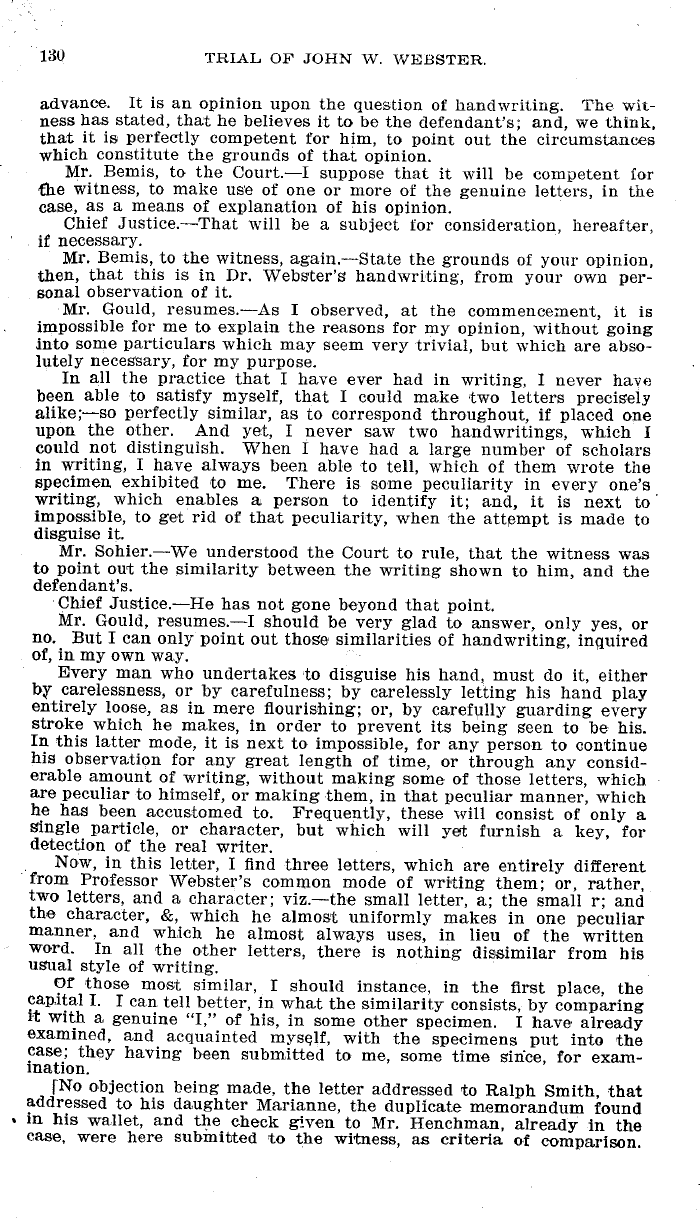|
130 TRIAL OF JOHN W. WEBSTER.
advance. It is an opinion upon the question of handwriting. The. wit-
ness has stated, that he believes it to be the defendant's; and, we think,
that it is perfectly competent for him, to point out the circumstances
which constitute the grounds of that opinion.
Mr. Bemis, to the Court.-I suppose that it will be competent for
the witness, to make use of one or more of the genuine letters, in the
case, as a means of explanation of his opinion.
Chief Justice.-That will be a subject for consideration, hereafter,
if necessary.
Mr. Bemis, to the witness, again.-State the grounds of your opinion,
then, that this is in Dr. Webster's handwriting, from your own per-
sonal observation of it.
Mr. Gould, resumes.-As I observed, at the commencement, it is
impossible for me to explain the reasons for my opinion, without going
into some particulars which may seem very trivial, but which are abso-
lutely necessary, for my purpose.
In all the practice that I have ever had in writing, I never have
been able to satisfy myself, that I could make two letters precisely
alike; so perfectly similar, as to correspond throughout, if placed one
upon the other. And yet, I never saw two handwritings, which I
could not distinguish. When I have had a large number of scholars
in writing, I have always been able to tell, which of them wrote the
specimen exhibited to me. There is some peculiarity in every one's
writing, which enables a person to identify it; and, it is next to
impossible, to get rid of that peculiarity, when the attempt is made to
disguise it.
Mr. Sohier.-We understood the Court to rule, that the witness was
to point out the similarity between the writing shown to him, and the
defendant's.
Chief Justice.-He has not gone beyond that point.
Mr. Gould, resumes.-I should be very glad to answer, only yes, or
no. But I can only point out those similarities of handwriting, inquired
of, in my own way.
Every man who undertakes to disguise his hand, must do it, either
by carelessness, or by carefulness; by carelessly letting his hand play
entirely loose, as in mere flourishing; or, by carefully guarding every
stroke which he makes, in order to prevent its being seen to be his.
In this latter mode, it is next to impossible, for any person to continue
his observation for any great length of time, or through any consid-
erable amount of writing, without making some of those letters, which
are peculiar to himself, or making them in that peculiar manner, which
he has been accustomed to. Frequently, these will consist of only a
single particle, or character, but which will yet furnish a key, for
detection of te real writer.
Now, in this letter, I find three letters, which are entirely different
from Professor Webster's common mode of writing them; or, rather,
two letters, and a character; viz.-the small letter, a; the small r; and
the character, &, which he almost uniformly makes in one peculiar
manner, and which he almost always uses, in lieu of the written
word. In all the other letters, there is nothing dissimilar from his
usual style of writing.
Of those most similar, I should instance, in the first place, the
capital I. I can tell better, in what the similarity consists, by comparing
it with a genuine "I," of his, in some other specimen. I have already
examined, and acquainted mysglf, with the specimens put into the
case; they having been submitted to me, some time since, for exam-
ination.
(No objection being made, the letter addressed to Ralph Smith, that
addressed to his daughter Marianne, the duplicate memorandum found
in his wallet, and the check giiven to Mr. Henchman, already in the
case, were here submitted to the witness, as criteria of comparison.
|

